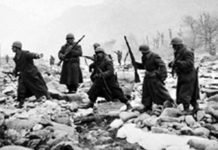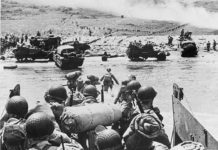The Gothic triumph in the Battle of Adrianople exposed Roman military weaknesses on the battlefield. The Goths were victorious because of their successful usage of cavalry against the Roman infantry.This Gothic victory opened the door for further German attacks, beginning a domino effect that ended Roman imperial domination in Western Europe.
On August 378 CE, the battle took place between the rebellious Goths and a Roman army that had been called together to suppress the Gothic rebellion. The actual fighting occurred about 13 kilometers from Adrianople, modern Edirne, near the conjunction of the borders of Greece, Bulgaria, and Turkey just west of Istanbul. The conflict involved the field army of the Eastern Roman Empire, commanded by the Emperor Flavius Valens, opposing a mixed Gothic army, with a core consisting of the Tervingi tribe under Fritigern, supported by Greuthungi led by Alatheus and Saphrax and other Gothic tribes.
The Goths made a treaty with the Romans in 376 CE that permitted them to settle within the empire, but the Goths rebelled because of the ill-treatment they received from the Romans. Valens intended to bring an end to this Gothic threat, but he attacked prematurely based on bogus intelligence reports about the Gothic inferior numbers, without waiting for the Western Roman army under Emperor Gratian to arrive. During the battle, the Roman army was thoroughly defeated. Two-thirds of the Roman forces, about 15,000 soldiers, were killed, including Valens.
The Gothic Cavalrymen
The Gothic forces at Adrianople were equipped with heavy cavalry. The Gothic cavalrymen were mounted on strong horses that could carry the weight and body armor of its rider. The Gothic horses wore body armor to protect the animal from various weapons. Since their armored horse were less susceptible to crippling injuries, the Gothic horsemen were more willing to close with enemy and employ their weapon of choice, the thrusting spear with devastating impact and deadly effect. The Gothic cavalry tactics played a decisive role in the Battle of Adrianople.
Battlefield Analysis and Tactics
During the summer’s mid-day heat, advanced elements of the both Roman armies were moving towards the Goths. Valens foolishly decided to initiate a decisive battle before Gratian could arrive on the battlefield because he was seeking all the glory and faulty reconnaissance persuaded him that only half the Gothic forces were present.
The Battle of Adrianople developed in several stages. First, the Romans advanced in column towards the Gothic encampment. As the Roman army approached, the Goths adopted a defensive formation, circling their wagons into laagers to protect their women and children. They protected their makeshift defense with infantry.
Second, the Roman army was suffering from heat exhaustion, thirst, and hunger, and in the absence of the Gothic cavalry a truce was being negotiated, when a disorderly attack by the Roman cavalry units provoked a general military engagement.
Third, after the Roman cavalry attack failed, suddenly the Gothic cavalry return from a foraging expedition and violently charged the Roman right flank, which resulted in the deaths of many Roman soldiers. As more returning Gothic cavalry arrive, they aggressively attacked the Roman’s exposed left flank. The Roman ranks were crushed together by Gothic cavalry attacks on both flanks until they broke entirely.
Finally, after the Roman cavalry was driven from the field in chaos, the Gothic cavalry continue their attacks on the Roman infantry’s flanks, rapidly surrounding and annihilating the Roman center. About two-thirds of the Roman army died on the hot summer battlefield, including Valens, whose body was never discovered.
Battlefield Impact and Significance
Although the Battle of Adrianople was significant because of Rome’s defeat, the conflict’s real impact was on the future of warfare. From the beginning of western warfare until the engagement at Adrianople, the infantryman with club, sword, and spear dominated the battlefield in European combat. Cavalrymen were deployed for occasional strikes, screening the flanks, and executing reconnaissance operations, but only a few warriors riding on horseback were employed directly against enemy forces.
This battlefield tactic changed with the Gothic victory at Adrianople. The Gothic cavalrymen became the predecessors of the Medieval Knights and many cavalry units that would dominate European Battlefields for the next 1000 years. Only when the English longbow archers’ defeated the French cavalrymen at Crecy (1346 CE) and Agincourt (1415 CE), the cavalry tactics of Adrianople began to disappear from many European battlefields. By the 20th century, horse cavalry had been replaced by armored mechanized cavalry on the ground and in the air where similar maneuvers and tactics were resurrected back to life again.
Sources:
- Lanning, LT. COL. (RET.) Michael Lee AND Bob Rosenburgh; THE BATTLE 100; Sourcebooks: New York, 2003.
- Roberts, Andrew and others; The Art of War; Quercus Publication, 2009.
- Zimmerman, Dwight, D.; The Book of War; Black Dog & Leventhal Publishers, 2008.
- Zimmerman, Dwight, D.; The Book of Weapons; Black Dog & Leventhal Publishers, 2009








